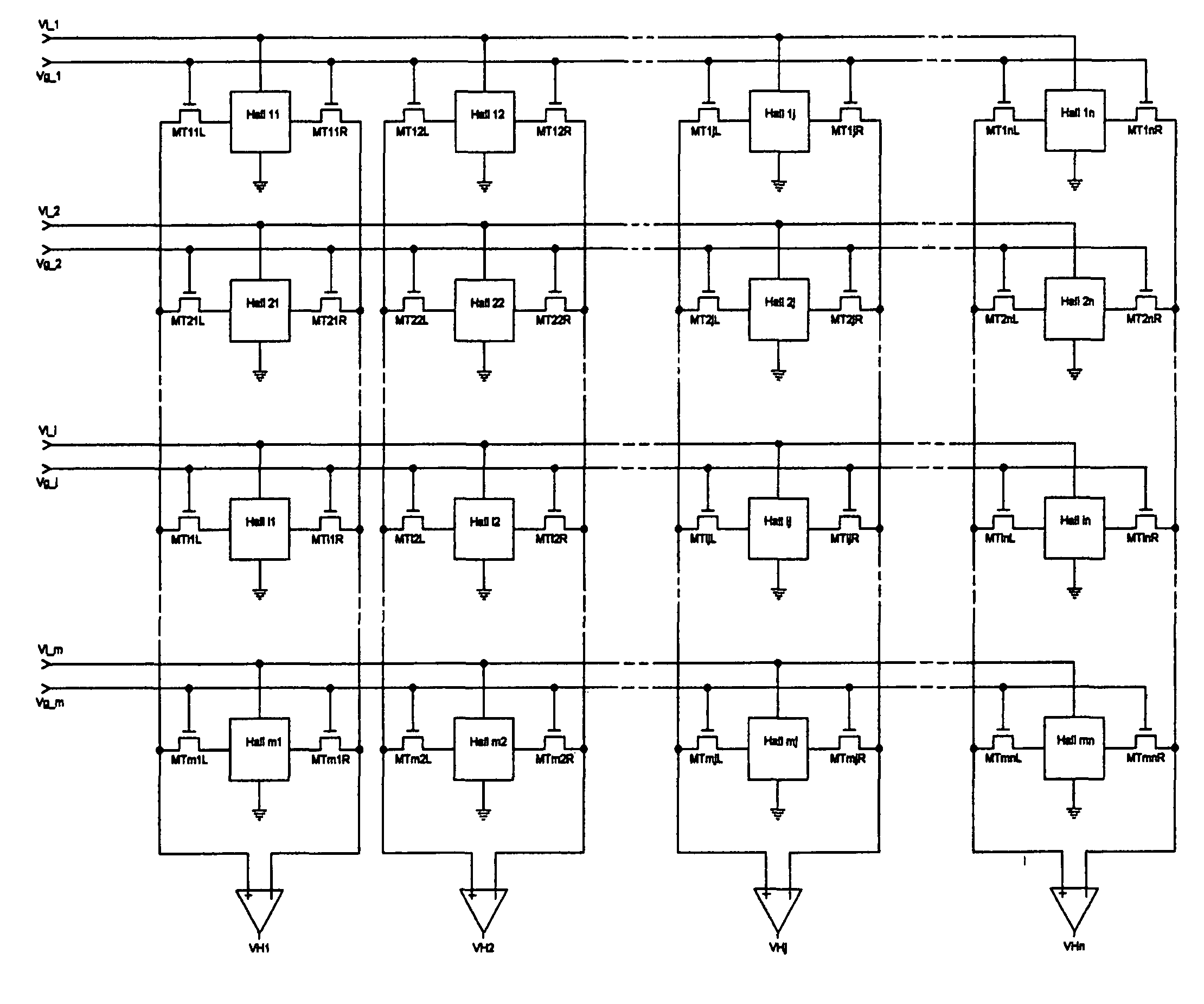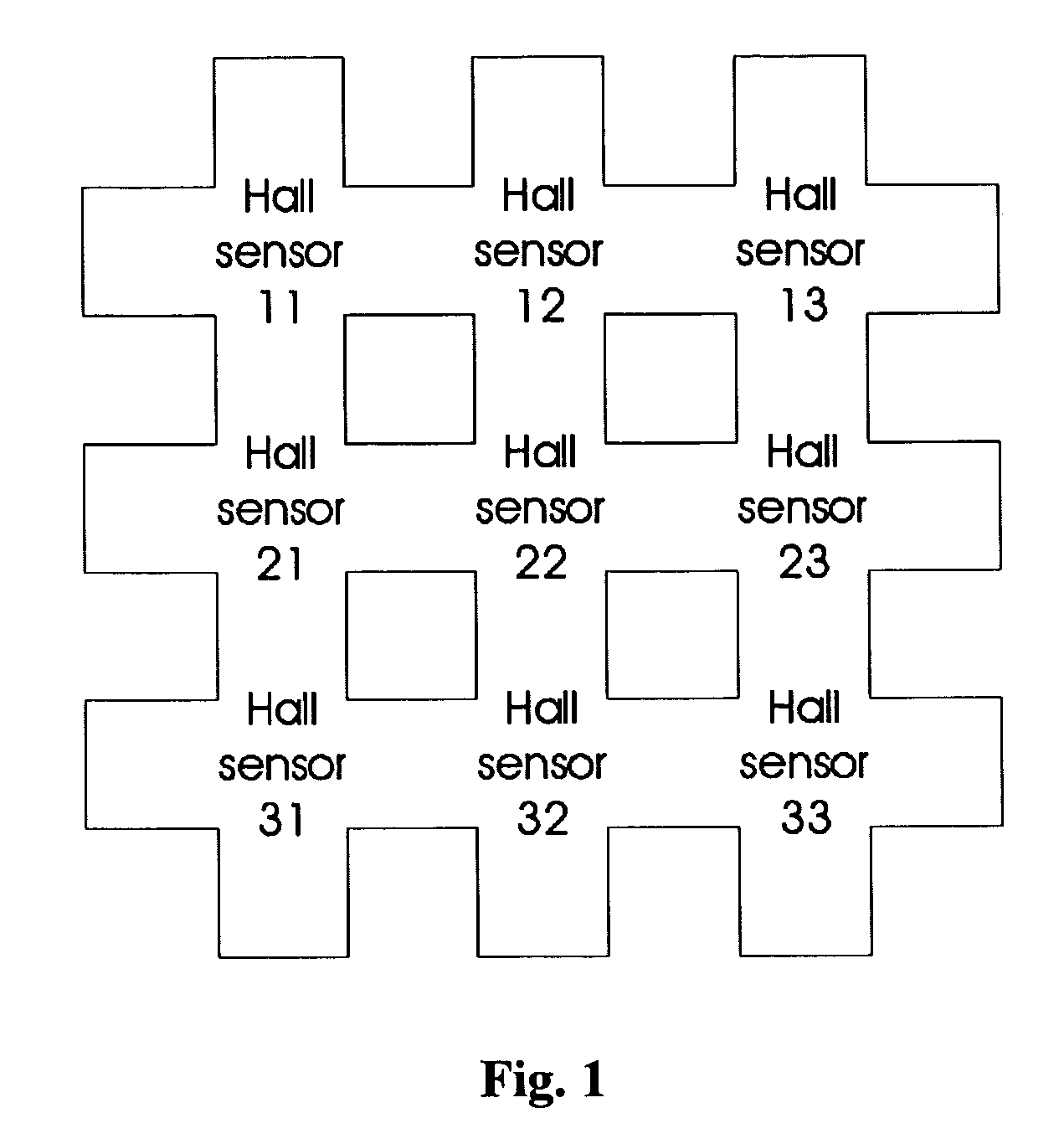Method and apparatus for detecting spatially varying and time-dependent magnetic fields
a spatially varying and time-dependent magnetic field technology, applied in the field of two-dimensional (2d) hall sensor array, can solve the problems of limited position resolution, slow and time-consuming process, and serious drawbacks of mos hall effect devices
- Summary
- Abstract
- Description
- Claims
- Application Information
AI Technical Summary
Benefits of technology
Problems solved by technology
Method used
Image
Examples
example 1
Working Principle
Semiconductor Material
[0101]The Hall sensors and switches are made from semiconductor material. This can be silicon, GaAs, InAs, InSb or an epitaxially grown III-V (or other) semiconductor heterostructure in which the heterojunction is made between a low band gap and a high band gap material such as GaAs / AlGaAs or GaN / AlGaN. In the case of semiconductor heterostructures, charge carriers (electrons) are provided to the semiconductor by a delta-doping layer (e.g. Si) in the case of GaAs / AlGaAs and by piezoelectric charges induced by the strained pseudomorphic epitaxy of AlGaN on GaN in the case of GaN / AlGaN. The electric fields inside the semiconductor induce a band bending which results in the formation of a quantum well at the heterojunction. The electrons are trapped in this quantum well and form a two-dimensional electron gas (2DEG) with high mobility at the position of the heterojunction. Mobilities in GaAs / AlGaAs range from more than 104 cm2 / Vs at room temperatu...
example 2
[0141]The processing of these two-dimensional Hall sensor array devices takes place in a cleanroom equipped with lithography facilities. The subsequent processing steps are best done by optical or electron beam lithography, but any other appropriate technique might as well be used.
[0142]The compatibility of semiconductor (preferably GaAs / AlGaAs or silicon) switches (preferably HMT or MOS transistors) with Hall sensors in the same material allows for a straightforward process flow.
[0143]The Hall sensors are preferably cross-shaped. Geometrically, a cross is constructed by intersecting two orthogonal bars, as shown in FIG. 21. A cross has four arms, as indicated in FIG. 8. The terms ‘bar’ and ‘arm’ in the text are used according to these definitions. Making use of this cross-shape, we were able to develop a very compact design, using the left and right arm (corresponding to the Lij and Rij contacts respectively, see FIG. 8) of each Hall sensor (i,j) cross as MTijL and MTijR ...
example 3
Apparatus
[0160]A two-dimensional Hall sensor array chip (FIG. 9) has been developed and successfully tested. This prototype was processed from a delta doped GaAs / AlGaAs wafer. The chip contains several two-dimensional Hall sensor arrays of varying dimensions ranging from 1×1 (single Hall sensor) to 10×10, as well as single HEMT transistors.
[0161]The gate dielectric is a 10 nm thick Al2O3 oxide. The passivation layer is a 100 nm thick SiO2 layer.
[0162]Several tests have been done in order to characterize these devices. Their results demonstrate the successful operation of the two-dimensional Hall sensor array.
Transistor Characterization
[0163]Individual HEMT transistors have been tested and characterized. FIG. 10 shows the drain-source current and the gate leakage current as a function of the gate-source voltage with constant VDS between 0.5V and 2V. For VGS=0V, the transistor channel is conducting. For VGST, the drain-source current has dropped several orders of magnitude and the res...
PUM
 Login to View More
Login to View More Abstract
Description
Claims
Application Information
 Login to View More
Login to View More - R&D
- Intellectual Property
- Life Sciences
- Materials
- Tech Scout
- Unparalleled Data Quality
- Higher Quality Content
- 60% Fewer Hallucinations
Browse by: Latest US Patents, China's latest patents, Technical Efficacy Thesaurus, Application Domain, Technology Topic, Popular Technical Reports.
© 2025 PatSnap. All rights reserved.Legal|Privacy policy|Modern Slavery Act Transparency Statement|Sitemap|About US| Contact US: help@patsnap.com



